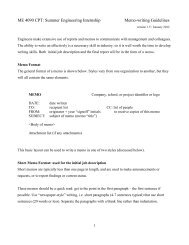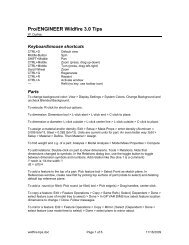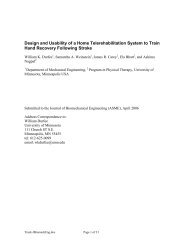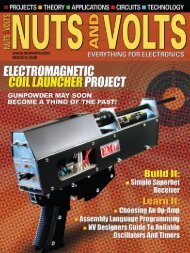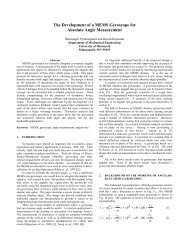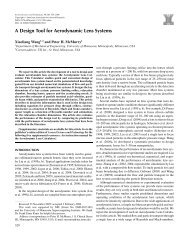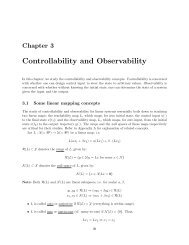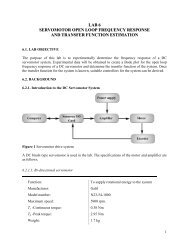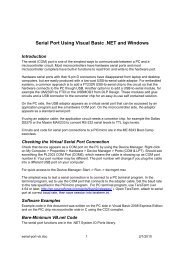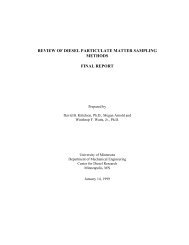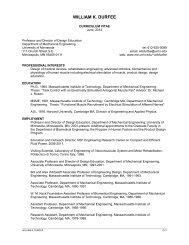Diesel Aerosol Measurement - Department of Mechanical ...
Diesel Aerosol Measurement - Department of Mechanical ...
Diesel Aerosol Measurement - Department of Mechanical ...
You also want an ePaper? Increase the reach of your titles
YUMPU automatically turns print PDFs into web optimized ePapers that Google loves.
precipitates out the high mobility electrons and negative ions. The positive particles are<br />
collected on a filter and the resulting current measured by an electrometer. The intensity<br />
<strong>of</strong> the particle photoemission is linearly related to the amount <strong>of</strong> particle-bound PAH’s<br />
and the particle surface area (Burtscher and Siegmann 1993).<br />
PAS instruments measure the photoemission from particles which is related to particle<br />
surface and gives a surface area concentration. Results from the studies cited are all<br />
reported as photoemission intensity over time. More details on the relation <strong>of</strong><br />
photoemission to PAH concentration, determined by chemical analysis are given<br />
elsewhere (Hart, et al., 1993).<br />
Only submicrometer particles may be irradiated and charged. Particles larger than 1 μm<br />
are removed from the aerosol before it enters the photoemission chamber because they<br />
cannot be charged efficiently. Lower particle size limits and concentration limits for the<br />
PAS instruments have not been reported. This method does not quantify individual PAH<br />
compounds. The detection limit is about 1 ng/m 3 with a time resolution <strong>of</strong> about 1s<br />
(Burtscher and Siegmann 1993).<br />
Mass Spectroscopy Instruments<br />
Mass spectroscopy has been used for decades to characterize the composition <strong>of</strong> aerosol<br />
particles. In principle, a particle is pulsed with a laser that desorbs/ionizes material that is<br />
measured by a mass spectrometer, indicating the chemical components <strong>of</strong> the particle<br />
(Gard, et. al. 1997, Noble and Prather 1996). Mass spectroscopy has an advantage over<br />
the photoemission method discussed above because it gives information for individual<br />
chemical components rather than total PAH content.<br />
Two time-<strong>of</strong>-flight mass spectrometers are described below. While the instruments<br />
provide information on the chemical composition <strong>of</strong> particles, neither instrument is<br />
currently capable <strong>of</strong> providing size resolved chemical characterization in the lower end <strong>of</strong><br />
the accumulation mode or the nuclei mode <strong>of</strong> diesel exhaust aerosols.<br />
<strong>Aerosol</strong> Time-<strong>of</strong>-Flight Mass Spectrometer (ATOFMS): The ATOFMS (Noble and<br />
Prather 1996 and 1998, Gard, et. al. 1997, Silva and Prather 1997) is unique in that it<br />
provides both real-time measurement <strong>of</strong> aerodynamic size and chemical composition <strong>of</strong><br />
individual particles from a polydisperse aerosol. The instrument can analyze up to 600<br />
particles per minute and can measure particles down to 0.3 μm in diameter.<br />
A particle enters the ATOFMS and is accelerated to terminal velocity by supersonic<br />
expansion <strong>of</strong> the carrier gas. Smaller particles reach a higher velocity than larger<br />
particles. The aerodynamic diameter is then determined by time-<strong>of</strong>-flight between two<br />
lasers before the particle enters the ionizing region <strong>of</strong> the mass spectrometer. Each<br />
particle is then pulsed by a laser. The resulting ions and molecules that are<br />
desorbed/ionized from the particle by the laser are measured by a mass spectrometer,<br />
indicating chemical components <strong>of</strong> the desorbed or ionized material. The spectrometer<br />
10



